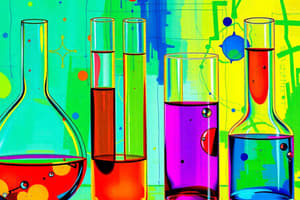Podcast
Questions and Answers
What advantage does Gas Chromatography have regarding sample size?
What advantage does Gas Chromatography have regarding sample size?
- It only functions with solid samples.
- It can analyze multiple samples at once without preparation.
- It requires a large volume of sample for accurate analysis.
- It works with very small sample sizes. (correct)
Which of the following is NOT a limitation of Gas Chromatography?
Which of the following is NOT a limitation of Gas Chromatography?
- Limited to volatile or derivatized compounds.
- Can analyze high molecular weight compounds effectively. (correct)
- Requires precise temperature control.
- Only suitable for non-polar compounds.
How does Gas Chromatography affect the thermal stability of sensitive compounds?
How does Gas Chromatography affect the thermal stability of sensitive compounds?
- It decreases the thermal stability, leading to degradation.
- It increases thermal stability, allowing tolerance for high temperatures. (correct)
- It modifies the compounds to enhance their volatility.
- It completely eliminates thermal sensitivity.
What type of analysis can Gas Chromatography perform regarding molecular weight?
What type of analysis can Gas Chromatography perform regarding molecular weight?
Which application of Gas Chromatography is associated with ensuring consistent formulations?
Which application of Gas Chromatography is associated with ensuring consistent formulations?
What is the primary function of the carrier gas in gas chromatography?
What is the primary function of the carrier gas in gas chromatography?
Which components primarily influence the separation of compounds in gas chromatography?
Which components primarily influence the separation of compounds in gas chromatography?
What characterizes gas-liquid chromatography?
What characterizes gas-liquid chromatography?
For an organic compound to be analyzed by gas chromatography, it must meet which of the following criteria?
For an organic compound to be analyzed by gas chromatography, it must meet which of the following criteria?
Which type of stationary phase is used in gas-solid chromatography?
Which type of stationary phase is used in gas-solid chromatography?
Which property should a carrier gas possess in gas chromatography?
Which property should a carrier gas possess in gas chromatography?
In the separation mechanism of gas chromatography, which process involves compounds interacting with a solid stationary phase?
In the separation mechanism of gas chromatography, which process involves compounds interacting with a solid stationary phase?
Which of the following carrier gases is commonly used in gas chromatography?
Which of the following carrier gases is commonly used in gas chromatography?
What is the typical flow rate range for packed columns in gas chromatography?
What is the typical flow rate range for packed columns in gas chromatography?
Which type of injector is suitable for injecting gas samples in gas chromatography?
Which type of injector is suitable for injecting gas samples in gas chromatography?
What is the main advantage of Wall Coated Open Tubular (WCOT) columns in gas chromatography?
What is the main advantage of Wall Coated Open Tubular (WCOT) columns in gas chromatography?
What stationary phase characteristic distinguishes Porous Layer Open Tubular (PLOT) columns from other column types?
What stationary phase characteristic distinguishes Porous Layer Open Tubular (PLOT) columns from other column types?
Which detector is commonly used in gas chromatography for detecting organic compounds?
Which detector is commonly used in gas chromatography for detecting organic compounds?
What is the particle size range needed for the solid support in packed columns?
What is the particle size range needed for the solid support in packed columns?
What is the preferred operating temperature limit for the Flame Ionization Detector (FID)?
What is the preferred operating temperature limit for the Flame Ionization Detector (FID)?
Which type of column would be most suitable for analyzing hydrocarbon compounds?
Which type of column would be most suitable for analyzing hydrocarbon compounds?
What is the primary function of a Thermal Conductivity Detector (TCD)?
What is the primary function of a Thermal Conductivity Detector (TCD)?
Which detector is highly sensitive to nitrogen and phosphorus-containing compounds?
Which detector is highly sensitive to nitrogen and phosphorus-containing compounds?
What advantage does temperature programming provide in gas chromatography?
What advantage does temperature programming provide in gas chromatography?
What is one requirement for the reagent used in the derivatization process for GC?
What is one requirement for the reagent used in the derivatization process for GC?
Which of the following compounds can a Photoionization Detector (PID) detect?
Which of the following compounds can a Photoionization Detector (PID) detect?
What is the primary purpose of silylating agents in gas chromatography?
What is the primary purpose of silylating agents in gas chromatography?
What is a characteristic detection range of the Electron Capture Detector (ECD)?
What is a characteristic detection range of the Electron Capture Detector (ECD)?
Which statement best describes the Flame Photometric Detector (FPD)?
Which statement best describes the Flame Photometric Detector (FPD)?
Flashcards are hidden until you start studying
Study Notes
Gas Chromatography
- Gas chromatography (GC) separates volatile organic compounds
- Uses a carrier gas (nitrogen, helium, hydrogen) as mobile phase and a liquid or solid as stationary phase.
Key Components
- Components of GC:
- Carrier Gas: Moves the sample through the column.
- Stationary Phase: Coated on the column's inner surface.
- Column: Separation of compounds occurs here.
- Detector: Identifies and quantifies separated compounds.
Factors Influencing Separation
- Boiling Point: More volatile compounds elute faster.
- Polarity: Non-polar compounds typically elute before polar ones.
Separation Mechanism
- Adsorption: Compounds interact with the solid stationary phase, sticking to the surface.
- Partitioning: A liquid (stationary phase) coats the adsorbent particles. More volatile compounds spend more time in the gas phase and move faster.
Types of GC
- Gas-solid chromatography: Mobile phase is a gas, stationary phase is a solid. Used for separating gases like air components, H₂S, CS₂, CO₂, CO, and oxides of nitrogen.
- Gas-liquid chromatography: Mobile phase is a gas, the stationary phase is a liquid retained on a solid surface.
Sample Properties for GC Analysis
- Volatility: Samples must be vaporized without decomposition.
- Thermal Stability: Compounds must withstand high temperatures (up to 400 °C).
- Low Molecular Weight: Ideal for analyzing small organic compounds, fatty acids, essential oils, and alcohols.
- Non-Polar/Moderately Polar: Compounds with lower polarity perform well in GC.
Instrumentation: Carrier Gas
- Types: Hydrogen (H₂), Helium (He), Nitrogen (N₂), Argon (Ar).
- Key properties:
- Inert (non-reactive) with the sample.
- Good thermal conductivity for heat transfer.
Stationary Phase
- Types:
- Uncoated solid material: Charcoal, silica gel.
- Inert solid with liquid coating: Diatomaceous earth coated with silicone.
- Direct coating of liquids: Silicone polymers bonded directly onto the column.
Flow Control
- Regulates the carrier gas flow in GC, ensuring column efficiency and reproducible elution times.
- Flow rates:
- Packed column: 10-60 ml/min
- Capillary column: 1-25 ml/min
Sample Injector
- Introduces the sample into the column
- Methods:
- Liquid samples: Injected using syringes.
- Gas samples: Injected via gas-tight syringes or gas-sampling valves.
- Key considerations:
- The sample should not decompose during injection.
- The vaporization chamber is heated 50 °C above the lowest boiling point to vaporize the sample and mix it with the carrier gas.
Columns
- Packed Column: Stationary phase is a liquid film adsorbed or bonded on a solid support.
- Length: 2-50 m; Inside diameter: 2-4 mm.
- Made of glass, metal, or Teflon.
- Diatomaceous earth is the most common solid support.
- Particle size: 0.15-0.26 mm.
- Capillary Column:
- Wall Coated Open Tubular (WCOT): Stationary phase is coated on the inner wall of the column.
- Thin layer on inner surface.
- Material: Fused silica or stainless steel.
- Diameter: 0.10-0.53 mm; Length: Up to 100 m.
- Advantages: High efficiency, low risk of overloading. Ideal for volatile/semi-volatile compounds.
- Support Coated Open Tubular (SCOT): Stationary phase is supported by a solid material layer.
- Solid support (e.g., diatomaceous earth).
- Diameter: 0.25-0.53 mm.
- Advantages: Higher sample load than WCOT. Suitable for samples needing larger stationary phase amounts.
- Applications: Hydrocarbon compound analysis.
- Porous Layer Open Tubular (PLOT): Column with porous solid material as the stationary phase.
- No liquid coating.
- Diameter: 0.32-0.53 mm; Length: 10-50 m.
- Advantages: High surface area for effective separation. Excellent for gas analysis.
- Applications: Natural gas, petrochemicals, permanent gases.
- Wall Coated Open Tubular (WCOT): Stationary phase is coated on the inner wall of the column.
Detectors in GC
- Common detectors: FID, TCD, ECD, NPD, and PID.
- Flame Ionization Detector (FID):
- Detects organic compounds by ionizing them in a hydrogen flame.
- High sensitivity and linearity.
- Temperature limit: 400°C.
- Detection range: 10⁻¹¹g.
- Thermal Conductivity Detector (TCD):
- Measures the change in thermal conductivity of the carrier gas.
- Universal detector with excellent stability.
- Detection range: 10⁻⁶g, temp: 10-400°C.
- Electron Capture Detector (ECD):
- Detects halides, nitriles, peroxides, etc.
- Detection range of 10⁻¹²g.
- Excellent sensitivity for detecting organometallic compounds.
- Nitrogen-Phosphorous Detector (NPD):
- Highly sensitive for nitrogen- and phosphorus-containing compounds.
- Uses hydrogen and air as mobile phases.
- Detection range: 10⁻¹³g for nitrogen.
- Working:
- Ionization in Hydrogen Flame: Compounds are ionized in a hydrogen flame.
- Rubidium Bead: Enhances ionization of nitrogen and phosphorus atoms.
- Signal Generation: Ions are collected by electrodes, generating a proportional electrical signal.
- Flame Photometric Detector (FPD):
- Measures light emitted from burning sulfur or phosphorus.
- Detection range of 10⁻⁷g
- Excellent specificity for sulfur compounds.
- Photoionization Detector (PID):
- Detects ethers, esters, and organosulfur compounds.
- Detection range of 20⁻⁹g.
- High linearity and stability.
Temperature Programming in GC
- Elevated temperature improves separation efficiency and decreases retention times.
- Temperature programming optimizes analysis for complex samples.
Derivatization in GC
- Converts non-volatile compounds (e.g., steroids, fatty acids) into volatile derivatives.
- Uses silylating agents, like TMS, to enable GC analysis.
- Requirements for Derivatization Reagents:
- Produce more than 95% complete derivatives
- Avoid rearrangements or structural alterations
- Not contribute to sample loss during formation of the derivative
- Produce a stable derivative that will not interact with the GC column
- Produce a derivative that is stable with respect to time.
- Silylating Agents in GC:
- React with functional groups like alcohols, amines, carboxylic acids, and esters.
- Common Silylating Agents:
- BSA: N,O-bis(trimethylsilyl)acetamide.
- BSTFA: N,O-bis(trimethylsilyl)trifluoroacetamide.
- TMSIM: N-trimethylsilylimidazole.
- Significance:
- Enhanced volatility; improves the volatility of non-volatile or semi-volatile compounds.
- Increased thermal stability; Allows sensitive compounds to withstand high GC temperatures.
- Reduced polarity; Improves peak shape and resolution in GC.
Analysis by Gas Chromatography
- What Can Be Determined:
- Compound Identification: Separates and identifies individual components in mixtures.
- Quantitative Analysis: Measures the concentration of compounds.
- Purity: Assesses the purity of a substance by detecting impurities.
- Volatility: Determines how easily compounds vaporize.
- Molecular Weight: Analyzes low molecular weight compounds.
- Thermal Stability: Detects compounds that withstand high temperatures.
- Polarity: Differentiates between polar and non-polar compounds.
Advantages of Gas Chromatography
- High Sensitivity: Detects trace amounts of compounds.
- Rapid Analysis: Quick separation with short run times.
- Minimal Sample Required: Works with very small sample sizes.
- Handles Complex Mixtures: Efficient for multi-component separations.
Limitations of Gas Chromatography
- Limited to Volatile Compounds: Only suitable for volatile or derivatized compounds.
- Requires Temperature Control: Precise temperature management is needed.
- Not Suitable for High Molecular Weight Compounds: Larger molecules may require alternative techniques.
Applications of Gas Chromatography
- Purity Testing: Identifies impurities in drugs.
- Active Ingredient Quantification: Ensures correct dosage.
- Stability Testing: Detects degradation products.
- Residual Solvent Analysis: Measures trace solvents.
- Quality Control: Ensures consistent drug formulations.
- Bioanalysis: Monitors drug metabolism in biological samples.
Studying That Suits You
Use AI to generate personalized quizzes and flashcards to suit your learning preferences.



